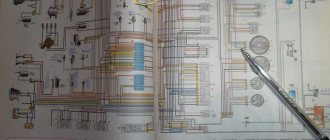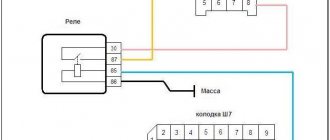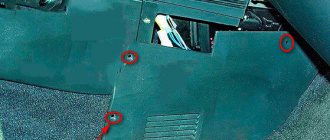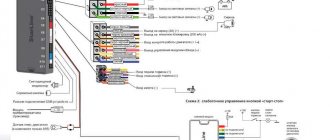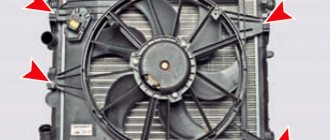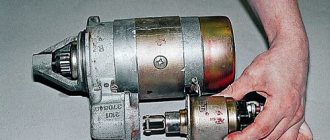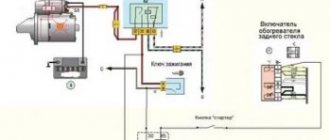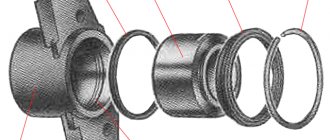Features of the scheme
The electrical circuit of the VAZ-2110 turn signals includes:
- lantern bulbs, six in total;
- two indicators installed on the dashboard;
- emergency button;
- Understeering's shifter;
- power supply;
- circuit breakers;
- interrupt relay.
The last two elements, responsible for the turn signal, are located nearby - in the mounting block. This unit is installed in the cabin, to the left of the steering wheel. It is closed by a decorative flap, to access which you just need to press the latch located above.
The emergency lights operate in parallel with the turn signals. Their wires are connected by the terminals of one block. It is from this that the veins go to the button that switches the general lighting devices to a mode signaling a breakdown that has occurred on the road. You need to know about this feature of the circuit when starting to search for the reasons for the failure of the lights. The problem is that a faulty VAZ-2110 emergency warning button often causes the turn signals to fail.
General information about turn signals
If you read the history of the creation of cars, then initially this part was not included in the package, and drivers installed it additionally for a fee. In modern cars, turn indicators are often placed on the headlight unit or next to it if they are front ones. The rear turn signal is mounted near the headlight. Repeaters of this necessary part can be placed on wings and mirrors. There is a technology for duplicating mirrors using diode lamps. This is now considered the most progressive.
The turn signal consists of the following parts:
- mechanical drive (for starting and shutting down);
- switch (to connect the lamps to the power source);
- relay, for closing and opening a circuit after a certain time.
Some cars have a very good functional solution - triple flashing when touched quickly; drivers really like this quality.
If you don’t have one, you can install a device that will increase the number of signals.
When the turn signal is activated, you hear a characteristic sound. In modern cars it can be changed to a more pleasant one. This car part gives a bright yellow, sometimes mixed with orange, glow. On American models, they are sometimes made red, which leads to an increase in emergency situations on the road, as they are confused with stop signals.
The simplest faults
When only one light bulb does not want to work, then most likely the problem lies there. A burnt-out element should be replaced with a suitable one. The turn signal indication mounted on the instrument panel will confirm the suspicion. Look at it - if the blinking is too frequent, then it is definitely a light bulb. When installing a new one, make sure that its power meets the manufacturer's requirements. If this point is ignored, then there is a risk that the alarm devices will not work properly in the future.
When neither the right nor the left turn signal of the VAZ-2110 turns on, and also does not respond to the activation of the emergency lights, then it is worth suspecting that the fuse has blown. It is located, as previously noted, in the mounting block. The number of the protective device is F16. Inspect the element and especially carefully examine its fuse-link.
Turn signal closes
See the rear headlight unit. The taillight board is the weak point of our cars. Most likely the problem again lies in the oxide of the tracks. As a result of corrosion, different tracks come into contact and short circuit, as a result of which the fuse then blows.
Why is such a mess going on with turn signals? When I turn on the left ones everything is fine, but when I turn on the right ones I hear a loud squeak and the turns just light up and don’t blink
- The turns and hazard lights of the VAZ 2108 are blinking dimly – 2 answers
- The front right turn signal in the VAZ 2108 does not work - 2 answers
- The side lights blink instead of the turn signal, VAZ 2109 - 2 answers
- How to fix turn signals and hazard lights? – 2 answers
- Rear turn off 21099 – 2 answers
More serious problems
If it turns out that nothing happened to the fuse, then you will have to check the relay responsible for the turn signals. It is located in the mounting block in place K3. This electromagnetic breaker sometimes fails. A break in the windings or jamming of the armature may occur here.
Testing a relay is easy. Do this:
- remove the protective casing from the device;
- activate the ignition;
- close the contact group with a small piece of copper wire.
After this, leave the cabin and look at the turn signals. The relay will have to be replaced if the lights start to glow continuously. When it turns out that they are not burning at all, then it is necessary to start ringing the cables and connectors. In the latter, contact is lost very often. Sometimes the leads oxidize, and then the contact resistance increases, which provokes burning. Clean the terminals with a file, a student's eraser, or alcohol. Be sure to make sure that all wires connected to the terminals are securely fastened.
Turn signals don't turn on
Sometimes it happens that the turn signals of the VAZ 2114 do not work.
This may be expressed by the following signs:
- The turn signals do not turn on.
- The turn signals do not turn off.
- The turn signals don't blink.
- The turn signals light up with minimal brightness.
In the first case, there may be several reasons (they are almost the same as in the case of problems with emergency lights):
- fuse is blown;
- power buttons are broken;
- contacts have oxidized;
- there was a break in the wiring;
- the relay has failed;
- light bulbs burned out.
Checking the electrical system of turn signals in these situations, as well as eliminating detected problems, should be carried out in the same way as repairing emergency lights (how exactly is described above).
If the turn signals, on the contrary, do not turn off, then there can only be one reason - burnt out switches. They should be replaced with new ones of a similar model.
Sometimes the turn signals may turn on, but remain solid instead of blinking. The reason for this is the incorrect operation of the relay (sometimes this also happens when a device intended for other cars is installed instead of the original relay). To eliminate the cause, it is enough to replace the relay with a new one.
If the turn signals are on but not blinking, you can try gently knocking on the relay body - sometimes this can help, but the effect is usually short-lived.
In a situation where the turn signals are very dim, you should check the power of the lamps installed in them. If the lamps are suitable, then you need to clean the ground contact connected to the turn signals. This can be done with fine sandpaper or kerosene.
We are looking for a breakdown with our own hands
Primary diagnostics can be carried out with a test light, but a tester is required to check the condition of the circuit. If you know, then in the resistance measurement mode you can independently “ring” the wiring for a break.
The search for the reason why the turn signals and emergency lights stopped working should begin with studying the electrical circuit. We recommend that you refrain from self-repair if you are unfamiliar with the basics of electrical engineering and methods for restoring wiring.
If you clearly hear the relay clicking when you turn on the right/left turn signal, check the resistance of the section of the circuit with the steering column switch. If only the left or right side does not work, the reason is definitely in the switch or in the wiring of the circuit from it to the light bulbs.
If the turn signal relay does not click at all, check the condition of the contacts, the positive wire and ground. If, after turning on the ignition, “+” does not come to the relay, the problem is most likely in the section of the circuit from the mounting block to the relay.
Understeering's shifter
The cause of the malfunction can be either mechanical damage to plastic or contact elements, or the formation of carbon deposits. During operation of the turn signals, the contacts may burn out, which increases the resistance and reduces the current in the circuit. It is typical that in the case of oxides and carbon deposits, the indicator relay may click, but the lamps will not light up.
To repair the steering column switch, you will need to remove it from the steering column and disassemble it. There are many contact pads inside the case, so for trouble-free assembly, remember the location of all moving elements.
Where is it located and how to check the turn signal relay
The turn signal relay is located in the fuse box in the passenger compartment or under the hood. You can find out the exact location from the repair and operation manual of your car. Often on the inside of the mounting block the purpose of the relays and fuses is graphically depicted.
Soldering of elements from the circuit, microcracks in solder joints, failure of the main microcircuit are the most common causes of turn signal failure.
Emergency crew
The hazard warning button imitates the steering column turn switch, but closes both contacts at once (on the right and left sides). The video shows the design and operating principle of a simple system, analogues of which are used not only on VAZ cars.
Car owners are sometimes concerned with such a problem as faulty turn signals, but not everyone knows how to solve this problem quickly and effectively. Accordingly, in the event of such a breakdown, continued movement, especially in city traffic, will be extremely dangerous. The most rational option would be to stop and fix this problem.
Types of turn signal problems and methods for eliminating them
The turn signal functions correctly only if the following indicators are met:
— the turn signals are always in operating mode when the ignition is on;
When switching the steering column lever up or down, the turn signal on the corresponding side should turn on;
The signal that alerts drivers to a turn flashes at a rate of 60 beeps per minute.
If the behavior of the signals is changed relative to the above indicators, then there are problems. The following are the most common types of turn signal problems:
1) The turn signal does not blink
It will be easier to solve this problem if you become familiar with the basic principle of relay operation. The current that passes through the lamps heats the measuring resistor - an element that determines the need to turn on a particular lamp at the right time. Accordingly, the lamp resistance, which differs from the nominal one, changes the time during which the turn signal turns on - it begins to blink.
In this situation, you need to lightly tap the relay. This will help if there is poor contact or moisture has entered. If the relay has been replaced, but the turn signal still does not blink, but remains constantly on, then the problem lies in poor contact with the safety block.
In this case, replacing a fuse with a resistance value that is radically different from the nominal one should help.
2) One turn signal does not work
If only one turn signal does not work, then this is in no way related to a faulty relay.
Then a failure would occur in both turn signals at once. The first option that may come to mind is a burnt out light bulb, or a problem in the wiring or socket. The new replacement bulb must not only fit into the turn signal socket, but also be of the same power as indicated on the lampshade. If, after replacing the light bulb, the turn signal still does not work, then inspect the socket. There may be traces of oxidation that will need to be removed with a file or sandpaper.
Also, the light bulb may sit very tightly on the contacts, which need to be bent using needle-nose pliers. This must be done with the greatest possible caution so as not to short-circuit the contacts. This can lead to another problem - the turn signals will start working in a staggered manner. If the cartridge is in excellent condition, then the problem lies in the wiring itself. First make sure the wire is firmly soldered to the socket. Do not allow wires to short to each other or to ground on the metal body of the car.
3) Hazard lights do not flash
In this case, the problem clearly lies in the relay. It needs to be replaced. Another reason for a non-working turn signal could be the switch. To check it, get to the steering column shift lever and dismount it. If the hazard lights do not work even though the turn signals are working, simply replace the button that turns on the alarm.
4) The turn signal is not bright enough
If they emit dim light, then you should check the model and wattage of the bulb. If everything is normal, you just need to clean the contacts of the light bulbs.
5) The turn signal relay clicks
This is not the norm. All the “salt” is contained in the relay contacts of the mounting block. Such sounds occur when the contact is too tight or oxidized. A poorly functioning relay can also lead to this. Install a new relay or clean the contacts.
If the turn signal does not show signs of life on one side of the car, either at the back or at the front, this means that there is a problem with the steering column switch, contact is lost or the entire relay is broken. The electrical circuit of the turn signal is protected by an 8-amp fuse, which is located in the mounting block. If it breaks, then such a nuisance may occur as failure of the turn signals on one side of the car. The hazard warning light system ensures safe driving, so every motorist is required to carry light bulbs of the required power with him.
How to indicate the direction of travel when the turn signals are faulty?
As you already understand, there are cases when light signals, as well as sometimes sound signals, cannot be used to express your intentions on the road. That is why we will further tell you how to indicate the direction of movement with hand gestures. A certain number of such manipulations are recorded in the traffic rules.
1)
If the left turn signal does not work, you need to extend your left arm to the side out of the window.
2)
To indicate a right turn, the left arm is extended out of the window, bent at a right angle with the hand up.
3)
The brake signal is given by raising your hand.
Besides:
1)
The driver waving his hand means allowing the pedestrian to pass.
2)
If your car behaves strangely on the road, you will be pointed towards the side of the road.
3)
If the driver forgot to turn on the light, he will be reminded of this with a gesture similar to a flashing light bulb.
4)
If you forgot to close the trunk, then you will be shown this by clapping your palms in the air. And an open door or a belt pressed against it will be indicated by slamming on the door.
5)
If they describe a circle to you in the air with their hands, one of your car’s tires is flat.
Turning lights are an integral element of optics in any modern car. Their purpose is to warn other road users that the driver is planning to make a maneuver. For what reasons there is no emergency signal, how to check the functionality of optical elements and how to repair them. We will talk about this below.
[Hide]
Instructions for repairing and replacing turn signals and hazard warning lights with your own hands
Before removing and replacing failed lighting devices with white or yellow ones, you must turn off the ignition and battery. This will avoid short circuits. Replacement work must be carried out with gloves to avoid staining the glass of the light bulbs.
How to change lamps in software:
- First you need to disconnect the connector with the connected wires from the optics.
- Then the spring tip is released.
- Now press on the mount located between the optic and the rotation. Remove the block with the software light source from the seat.
- Bulbs that are not working are replaced and reassembled in the reverse order.
- As for the repeaters, to replace, remove its body from the seating location along with the rubberized gasket, about half a centimeter forward.
- Remove the back of the device from the installation location.
- Remove the repeater completely, then disconnect the plug and wiring and remove the gasket. After this, the gasket itself must be installed on the new repeater.
- Now all that remains is to reconnect the plug with the wiring and install the repeater back.
Turn signals do not work on VAZ-2114
Problems with turn signals can occur both in VAZs with a carburetor engine and in models with an 8-valve injector. It gives more power to the engine and other benefits, while making troubleshooting more difficult.
A turn signal may not work well most often due to burnt out electrical contacts or if the integrity is damaged (a problem with the sealant). The instrument panel may indicate that there is a problem. You will notice a discrepancy between the signal and the turn button: the presence of a flashing headlight.
This malfunction is considered simple, but relatively common. If you figure out why this happened, then carry out the repair yourself and without any problems. The electronics here are simple and accessible to any driver who is minimally familiar with the operation of electrical circuits and has attended physics classes at school.
Let's look at the main causes of the malfunction and how to eliminate them:
- If there is no turn indicator signal, then in 90% of cases you need to replace the electrical relay or check how the contacts are connected to it. The relay is indicated by the symbol K1. Possible depressurization and liquid ingress. If after replacing the relay with a new one, the malfunction remains, then you need to carefully inspect the fuses. Perhaps one of them has burned out and needs to be replaced; it is better to check the entire unit.
- Don't forget to check the quality of fuse F12, as well as how it functions with everyone. Check the functionality of the switch itself, there may well be a malfunction there.
- Sometimes the emergency warning button fails. If this is the case, we can easily replace it with another one that works normally.
- If the turn signal lamp does not turn on, check the functionality of the device. She could simply burn out.
- If it is impossible to turn off the turn signal, a simple action is taken: the switch is replaced.
- Frequent blinking indicates problems with the lamp; it is better to replace it. If after replacement the result is the same, then the contacts have probably deteriorated (oxidized) and need to be replaced or cleaned. Sometimes it is a matter of failure of the tracks on the block.
- Dim glow. There are several reasons for this phenomenon: a mismatch in the power of the lamp required for a given turn signal. In this case, it is enough to purchase a lamp with the required parameters and replace it.
- Atypical relay sounds. With such a malfunction, the turn signals do not turn on according to your wishes. In such a situation, as a rule, the electrical relay should be replaced. It would be ideal if you purchase an original car from the factory that matches the model, so you will achieve long-term good performance.
- If the right turn signal does not work, then you need to carefully examine the right headlight. Its electrical board often malfunctions due to oxidation, therefore, the supply of electric current is disrupted. As a result, problems are possible with both the relays and fuses, and accordingly the turn signals stop working.
Turn signal problems are problems with your vehicle's electrical wiring and electronics. Therefore, if you are not strong in this matter, if problems of this kind arise, contact either a service station or an auto electrician.
Why is the turn signal flashing quickly?
Such a small nuisance can happen to anyone and, in most cases, there is nothing serious about it. For example, the most common reason that the turn signal blinks very quickly may be that one of the bulbs has burned out. For example, if at least one turn signal bulb burns out - front, rear, or additional - this is quite enough for the current resistance in the network to change. The result is that the entire side where the bulb is faulty will blink very quickly. You just need to screw in a new lamp and everything will be fine.
If the left or right turn signal blinks quickly, but all the lights are working, then the problem is of a different nature. Alternatively, it is possible that carbon deposits, rust, or dirt have formed on the lamp base and in the socket contact itself, making the contact unstable. This may well be the reason why the turn signal of the VAZ 2109, or any other car, is flashing quickly. To solve this problem, you will have to disassemble all the turn signals and clean all the lamps and contacts.
The turn signal on the VAZ 2107 flashes quickly much less often due to a faulty turn signal relay. As a rule, relays last for decades, so this reason can be considered an exception.
Finally, another reason that the turn signal blinks quickly is the installation of LED lamps rather than ordinary incandescent lamps. LED lamps have a completely different resistance, so their installation can also cause frequent blinking of the turn signal.
If all these options do not suit your case, if the light bulbs are new, the contacts are clean, the relay is working, the fuses are intact - you are out of luck, since the problem is in the wiring itself. If you are not an electrician, then you will not be able to deal with this trouble yourself - contact a car service center.
We hope that we were able to help you solve the problem of why the turn signal is blinking frequently. Read more of our articles, improve your knowledge, because car repair is easy.
I replaced the turn switch and it doesn't work well. I turn on the turn (right and left), it blinks once, 2 times there is sound, but without the turn signal blinking, on the 3rd and further there is no sound and no blinking. I took it apart and reinstalled it several times. The alarm works flawlessly and the fuses are also ok.
The power supply circuit for the VAZ 2114 turn signals includes a steering column switch, a relay, a fuse, an alarm switch, lamps and wiring.
Each of these elements performs its own function. The switch supplies power to the necessary lamps. Additionally, voltage can be supplied through the emergency button, bypassing the switch. To protect the wiring from a possible short circuit in the turn signal wiring, fuses are included in the circuit.
The relay is responsible for interrupting the lighting of the lamps, that is, this element ensures the blinking of the turn signals. In addition, it makes it possible to determine the serviceability of all lamps. If at least one lamp burns out, the blinking frequency of all turn signals, as well as the warning lamp on the dashboard, will double.
If, after replacing the steering column switch, problems arise with the operation of this light alarm, in this case the one-time operation of the lamps is to blame for this relay.
Everything is simple here - if the switch was faulty, then the turn signals either would not work at all, or they would work in one mode, for example, the right turn signals would blink, but the left ones would not.
The fuses also disappear, since if they blew, no power would be supplied to the circuit, that is, the turns would not work at all.
The relay is not an expensive part, so it is easier to replace it than to repair it.
Still, before replacing this component, it is recommended to first check its functionality. To do this, you can borrow this element from another car or install your relay on another car.
Replacement is easy. On the VAZ 2114 this element is located in the fuse box. Under the cover of this block there is a diagram of the location of all fuses and relays, using it you can easily find the necessary element.
If there is no diagram, then it is easy to determine what you need - it is located in the top row, second from the left. It does not have any fastening, it is simply installed with its plugs in the connectors.
It is worth noting that you must purchase and install on your car only a relay recommended by the manufacturer, in this case model 493.3747. It is also possible to install analogues, of which there are many on the market now, but first you should inquire about the operating parameters, which are usually marked on the body. The characteristics of the failed and purchased elements must completely match.
All that remains is to install a new element in the fuse box and check the functionality of the turn signals.
Turning lights should be in working order in any car. This type of optics allows other road users to know your intentions when making maneuvers, so the performance of turns has a large impact on safety. What to do if the VAZ 2114 emergency light does not work, how to identify the problem and replace the lamps? Read about it below.
